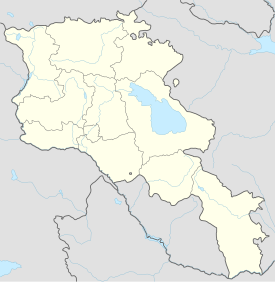Tegher Monastery
| Tegher Monastery Տեղերի Վանք |
|
|---|---|

The Monastery of Tegher.
|
|
| Basic information | |
| Location | Near the modern village of Tegher and across the gorge from Byurakan, Aragatsotn Province, |
| Geographic coordinates | 40°20′42″N 44°14′26″E / 40.345092°N 44.240544°ECoordinates: 40°20′42″N 44°14′26″E / 40.345092°N 44.240544°E |
| Affiliation | Armenian Apostolic Church |
| Architectural description | |
| Architect(s) | Vardapet Aghbayrik |
| Architectural style | Armenian |
| Completed | 13th century |
Tegher Monastery (Armenian: Տեղեր or Տեղերի Վանք; also Tegheri Vank) is an early 13th-century Armenian monastery and church located on the southeastern slopes of Mount Aragats near the modern village of Tegher, and across the gorge from the village of Byurakan in the Aragatsotn Province of Armenia. It was built for Princess Khatun (also known as Mamakhatun), the wife of Prince Vache Vachutian who had purchased the district of Aragatzotn from the Zakarian brothers. The architect Vardapet Aghbayrik designed Tegher and the monasteries of Saghmosavank and Hovhannavank during the 13th century. The monastery survived intact during a time when Mongol invasions plagued the lands.
Ruins of the 9th century village of Tegher (Old Tegher) sit a short distance walk from the monastery. Numerous foundations may be seen, along with the remains of a Tukh Manuk funerary chapel of the 5th century. Nearby is also the medieval to 19th century cemetery with some mausoleums and khachkars.
The church of Surb Astvatsatsin was built in 1213, and is constructed from dark gray basalt. It is a cruciform type plan with a chamber in each of the four corners and a semicircular apse at the end of the hall. A central tall round drum rests above with a tent style dome, supported by the corners of the square which is supported by columns below. The roof of the church is gabled. The structure is simply decorated except for the cornice moldings and accentuation of the arches in the main area. From the exterior, the building is rectangular with two wall niches and windows on the north, east, and south.
...
Wikipedia

